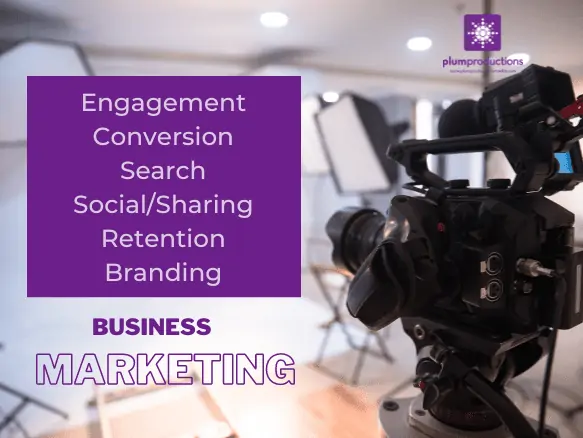Enhancing Video Marketing Strategies for Maximum Impact
Interested in learning how to measure your video marketing activities? This article provides 13 metrics you should consider when measuring success when creating content.
Video Marketing Success Metrics
Today video marketing continues to be an important tool for businesses aiming to captivate audiences and drive sales. However, contrary to the outdated notion that views are the sole metric of success, the modern approach emphasizes a broader set of performance indicators tailored to specific marketing goals. This updated perspective is crucial for developing strategies that not only attract views but also foster engagement and conversion.
Key Performance Indicators (KPIs) for Video Marketing
The initial step in any video marketing campaign is to clearly define the primary marketing goal. Whether the aim is to boost awareness, increase consideration, or drive actionable results, understanding the desired outcome shapes the strategy and the metrics to track.
- Awareness Metrics:
- Views: Measures the total number of views to gauge initial interest and reach.
- Impressions: Tracks how often your video appears in search results or feeds, essential for understanding visibility.
- Unique Users: Indicates the diversity of the audience, showing how many individual viewers your content attracted.
- Brand Recall: Assesses how well viewers remember the video after watching, a crucial indicator of impact.
- Consideration Metrics:
- View-Through Rates: Represents the percentage of viewers who watch the video from start to finish, indicating content engagement.
- Watch Times: Measures the total amount of time viewers spend watching the video, reflecting content relevance and engagement depth.
- Favorability: Quantifies changes in viewer perception towards the brand post-viewing, crucial for gauging sentiment.
- Consideration Lifts: Assesses how much more likely viewers are to consider your brand for purchase after watching the video.
- Action Metrics:
- Clicks: Tracks the number of actionable engagements like clicking on a CTA, crucial for conversion tracking.
- Calls: Measures the volume of calls received as a direct result from the video content, indicating lead generation success.
- Signups: If applicable, this gauges the number of signups or subscriptions initiated from the video, reflecting direct engagement.
- Sales: Tracks the conversions resulting directly from the video, crucial for ROI analysis.
- Purchase Intent Lifts: Evaluates the increase in purchase intent among viewers post-exposure, linking content effectiveness to potential sales.
Crafting a Digital Funnel with Video
Creating a digital funnel with video is a strategic process that involves understanding your audience’s position in the buyer’s journey and delivering targeted video content that moves them towards a decision. Here’s how you can effectively create this funnel:
- Top of the Funnel – Attracting Attention
Use introductory videos that address common questions or concerns to attract a broad audience. These might be videos like Frequently Asked Questions or Commonly Searched Questions about your services or products.
Focus on educational content that highlights the problems your product or service solves, effectively generating interest and brand awareness.
- Middle of the Funnel – Building Engagement:
In the broader videos, mention more focused content related to their question. Offer more detailed videos that dive deeper into how your products or services work, demonstrating their benefits and differentiating features.
It always helps to include customer testimonials and case studies to build trust and show real-world applications of your offerings. Find existing clients/customers who are willing to share their experience with your services.
- Bottom of the Funnel – Driving Action:
Feature strong call-to-action videos that encourage viewers to make a purchase, contact your company, or take another desired step.
Sometimes, using limited time offers and demos to create urgency and convert interest into sales works. Other times, it makes more sense to give the viewer an easy action to complete to connect them with you.
Throughout this process, tailor your video content to the specific needs and interests of your audience at each stage. By doing so, you guide them smoothly from awareness to consideration, and ultimately to action.
Example of a Top of Funnel Video
Integrating Video with Other Marketing Efforts
It’s crucial to recognize that video rarely works in isolation. Successful video strategies integrate with broader marketing activities to create a cohesive brand experience. Here are several ways to effectively integrate video with other marketing efforts:
- Email Marketing
- Embedding Videos in Newsletters: Increase open and click-through rates by including engaging video content in your email newsletters. Videos can summarize key messages, introduce new products, or share customer success stories.
- Personalized Video Emails: Use personalized videos to address individual customer needs, enhancing the personalization and impact of your email campaigns.
- Social Media Campaigns:
- Platform-Specific Content: Tailor your video content to fit the unique formats and audience preferences of different social media platforms. For example, create short, attention-grabbing clips for Instagram and TikTok, and longer, informative videos for YouTube and Facebook.
- Engaging with Followers: Use live videos and stories to engage directly with your audience, answering questions in real-time and fostering a sense of community.
- Content Marketing:
- Blog Integration: Enhance your blog posts with embedded videos that provide visual explanations, demonstrations, or additional context. This can improve engagement and time spent on your site.
- Video Blogs (Vlogs): Create vlogs to share industry insights, company updates, or behind-the-scenes looks at your business, adding a personal touch to your content marketing strategy.
- Search Engine Optimization (SEO):
- Video SEO: Optimize your videos for search engines by using relevant keywords in titles, descriptions, and tags. Transcripts and captions can also improve accessibility and searchability.
- Backlink Building: Share your videos across various platforms and encourage others to link to them, boosting your website’s authority and search ranking.
- Paid Advertising:
- Video Ads: Utilize video ads across platforms like Google Ads, Facebook Ads, and LinkedIn Ads to reach a wider audience. Targeted video ads can drive traffic to your site and generate leads.
- Retargeting Campaigns: Use retargeting strategies to show video ads to users who have previously interacted with your brand, reminding them of your offerings and encouraging conversions.
- Sales and Customer Support:
- Product Demos: Create video demos that sales teams can use during presentations or share with prospects to highlight product features and benefits.
- Tutorials and FAQs: Develop video tutorials and FAQs to assist customers in using your products, enhancing their experience and reducing support queries.
Using this information, you can create a unified and effective strategy that maximizes the impact of your video content and drives overall marketing success.
Video Marketing Metrics Can Change Often
Measuring the success of a video marketing campaign involves more than just counting views. By establishing relevant KPIs and integrating video into a comprehensive marketing strategy, businesses can better understand and enhance the impact of their video content.
Your metrics should match your desired outcomes. As the digital landscape evolves, so too should your methods for measuring success, ensuring that our marketing efforts are as effective and efficient as possible.
If you need assistance in refining your video marketing strategy to meet these standards, reach out and we can help.
Keywords: Video Marketing, Key Performance Indicators, KPIs, Marketing Goals, Digital Funnel, Brand Awareness, Viewer Engagement, Video Content Strategy, Marketing Integration.
Related Content:
4 Creative Ways Video Marketing Attracts New Patients




















